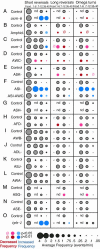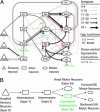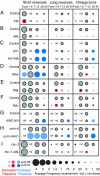A circuit for navigation in Caenorhabditis elegans
- PMID: 15689400
- PMCID: PMC546636
- DOI: 10.1073/pnas.0409009101
A circuit for navigation in Caenorhabditis elegans
Abstract
Caenorhabditis elegans explores its environment by interrupting its forward movement with occasional turns and reversals. Turns and reversals occur at stable frequencies but irregular intervals, producing probabilistic exploratory behaviors. Here we dissect the roles of individual sensory neurons, interneurons, and motor neurons in exploratory behaviors under different conditions. After animals are removed from bacterial food, they initiate a local search behavior consisting of reversals and deep omega-shaped turns triggered by AWC olfactory neurons, ASK gustatory neurons, and AIB interneurons. Over the following 30 min, the animals disperse as reversals and omega turns are suppressed by ASI gustatory neurons and AIY interneurons. Interneurons and motor neurons downstream of AIB and AIY encode specific aspects of reversal and turn frequency, amplitude, and directionality. SMD motor neurons help encode the steep amplitude of omega turns, RIV motor neurons specify the ventral bias of turns that follow a reversal, and SMB motor neurons set the amplitude of sinusoidal movement. Many of these sensory neurons, interneurons, and motor neurons are also implicated in chemotaxis and thermotaxis. Thus, this circuit may represent a common substrate for multiple navigation behaviors.
Figures





Comment in
-
Biography of Cornelia I. Bargmann.Proc Natl Acad Sci U S A. 2005 Mar 1;102(9):3181-3. doi: 10.1073/pnas.0500025102. Epub 2005 Feb 22. Proc Natl Acad Sci U S A. 2005. PMID: 15728356 Free PMC article. No abstract available.
References
Publication types
MeSH terms
LinkOut - more resources
Full Text Sources
Other Literature Sources

